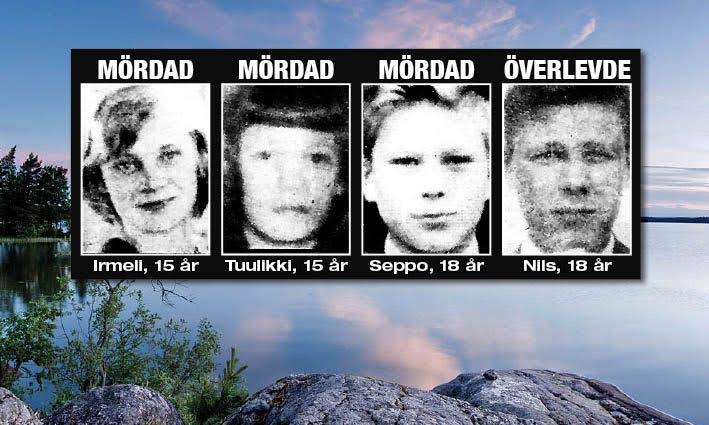The Bodom Lake Case

Brutal killing of a human being is a cruel act and killing three young people for no particular reason is even more cruel. The story of one such crime was read today during the search. Let's read the story of a famous unsolved murder case in this blog. Before starting the blog, let me tell you that this information has been obtained from various websites and people's research.
Three dead, one injured in the Lake Bodom Murders
Lake Bodom
Lake Bodom is a lake by the city of Espoo, about 22 kilometres west of Finland's capital, Helsinki. It is a beautiful lake measures almost 3 KM in length and 1 KM in width. This lake is notorious for an unsolved murder mystery.
Case
On Saturday, June 4th, 1960 two teenage couples camped at the lake.
Some time between 4 AM and 6 AM, an unknown man or men gruesomely killed three of them with a knife and blunt instrument wounding the fourth. A carpenter, Risto Sirén, discovered the bodies while jogging in the vicinity. The victims were all stabbed and beaten with a blunt, heavy object. The sole survivor, Nils Wilhelm Gustafsson, was found lying on top of the collapsed tent.
The victims were:
15-years old Maili Irmeli Björklund: Stabbed and bludgeoned.
15-years old Anja Tuulikki Mäki: Stabbed and bludgeoned.
18-years old Seppo Antero Boisman: Stabbed and bludgeoned.
18-years old Nils Wilhelm Gustafsson: Wounded but survived, having sustained a concussion, fractures to the jaw and facial bones and bruises to the face.
There have been numerous suspects during the investigation of Lake Bodom murders, but these suspects are the most notable.
Pauli Luoma
Luoma was a runaway from a nearby work department. Police caught him soon after the murders and questioned him. They found out that he had a valid alibi. He reportedly was in Otaniemi at the time of the murders.
Pentti Soininen
Pentti Soininen, a maintenance man, was convicted of several property and violent crimes in the late 1960s. At the age of 24, while in jail in the county of Kuopio, he confessed that he had committed the Lake Bodom murders. On the fateful night, Soininen, aged 15, resided near the site of the Lake Bodom murders. The police interrogated him, however his confession was not given much weight. Soininen was a psychopath who could be incredibly cryptic, especially while under the influence of alcohol and drugs. Soininen's long criminal record included theft, assaults, and robberies. In 1969, Soininen hanged himself at Toijala, a prisoner transport station.
Valdemar Gyllström
One of the prime suspects of the murders was Karl Valdemar Gyllström, a kiosk keeper from Oittaa. He was known to have hated campers and behaved aggressively. In Oittaa Gyllström was known as "Kiosk Man". He drowned in Lake Bodom in 1969, and while drunk he confessed the murders to his neighbor before his death, saying: "I killed them." Gyllström filled the well in his courtyard a few days after the murders and therefore Gyllström's house and the courtyard were studied in depth. Nothing incriminating was ever found. According to the police, Gyllström had an alibi for the night of the murders, which was given by his wife. Gyllström's wife said that she was awake the whole night and that her husband had not been away from home. However, the wife had said before her death that her husband had threatened to kill her if she told the truth.
Hans Assmann
Most suspicion has focused on the alleged KGB spy, Hans Assmann. On June 6, 1960 he came to the Helsinki Surgical Hospital. Assmann's behaviour in the hospital was particularly odd. The patient appeared dishevelled, with black fingernails and his clothes covered in red stains. Assmann may have lied to hospital staff about the cause of his appearance. He also pretended to be unconscious and was aggressive and nervous. Assmann's clothing matched the description of the Lake Bodom murderer. Assmann cut off his longish blond hair after details regarding the appearance of the murderer were revealed on the news. Assmann lived within five kilometres of Bodom, which was only a short distance from the shore of Lake Bodom. His behaviour could have suggested guilt at the time, especially as was noted by Surgical Hospital Curator Jorma Palo, as well as other hospital staff. The police had only a brief meeting with Turkham, but found little since they did not want to cross-examine doctors and did not take Assmann`s stained clothing for examination; in spite of the fact that the doctors in attendance were certain that the stains were blood. Later Palo published three books about true crime of Assmann and the murders. Former Detective Chief Inspector Matti Paloaro also suspected that Assmann was also responsible for five other murders. Assmann has been linked to unsolved Finnish homicides such as Kyllikki Saari's murder inIsojoki and the Tulilahti double murder in Heinävesi.
Nils Gustafsson
In late March 2004, almost 44 years after the event, Nils Gustafsson was arrested by the police on suspicion of having murdered his three friends. In early 2005, the Finnish National Bureau of Investigation declared the case was solved based on some new analysis on the blood stains. According to the official statement, Gustafsson erupted in jealous anger over his feelings for Björklund, his new girlfriend. She was stabbed multiple times after the fatal blow, while the two other teenagers were killed less savagely. Gustafsson's own injuries, while notable, were less severe.
The trial started on August 4, 2005. The prosecution called for life imprisonment for Gustafsson. It argued that the re-examination of the old evidence using modern techniques such as DNA profiling raises suspicion towards Gustafsson. The defense argued that the murders were the work of one or more outsiders and that Gustafsson would have been incapable of killing three people given the extent of his injuries. On October 7, 2005 Gustafsson was acquitted of all charges.
On his acquittal, the State of Finland paid him€44,900 for mental suffering caused by the long remand time.

 My First News Item
My First News Item My Nine News Item
My Nine News Item